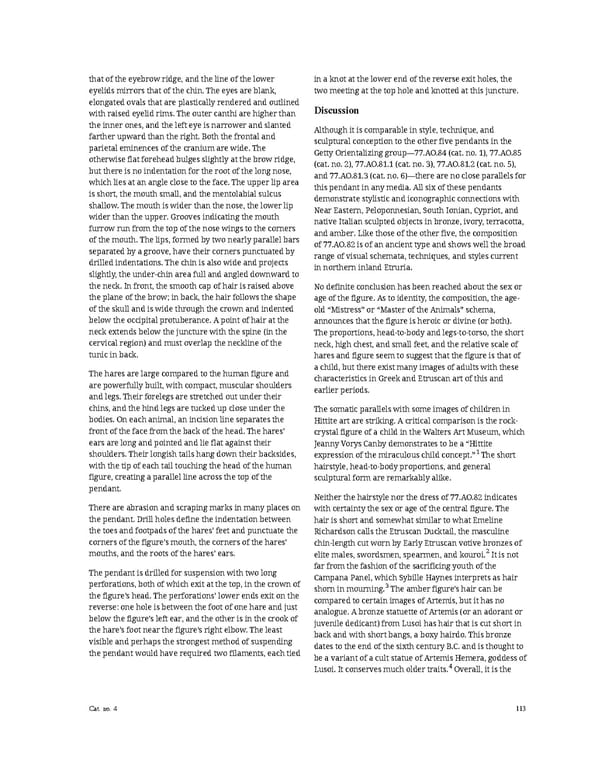that of the eyebrow ridge, and the line of the lower in a knot at the lower end of the reverse exit holes, the eyelids mirrors that of the chin. The eyes are blank, two meeting at the top hole and knotted at this juncture. elongated ovals that are plastically rendered and outlined Discussion with raised eyelid rims. The outer canthi are higher than the inner ones, and the left eye is narrower and slanted Although it is comparable in style, technique, and farther upward than the right. Both the frontal and sculptural conception to the other five pendants in the parietal eminences of the cranium are wide. The Getty Orientalizing group—77.AO.84 (cat. no. 1), 77.AO.85 otherwise flat forehead bulges slightly at the brow ridge, (cat. no. 2), 77.AO.81.1 (cat. no. 3), 77.AO.81.2 (cat. no. 5), but there is no indentation for the root of the long nose, and77.AO.81.3(cat. no. 6)—there are no close parallels for which lies at an angle close to the face. The upper lip area this pendant in any media. All six of these pendants is short, the mouth small, and the mentolabial sulcus demonstrate stylistic and iconographic connections with shallow. The mouth is wider than the nose, the lower lip Near Eastern, Peloponnesian, South Ionian, Cypriot, and wider than the upper. Grooves indicating the mouth native Italian sculpted objects in bronze, ivory, terracotta, furrow run from the top of the nose wings to the corners and amber. Like those of the other five, the composition of the mouth. The lips, formed by two nearly parallel bars of 77.AO.82 is of an ancient type and shows well the broad separated by a groove, have their corners punctuated by range of visual schemata, techniques, and styles current drilled indentations. The chin is also wide and projects in northern inland Etruria. slightly, the under-chin area full and angled downward to the neck. In front, the smooth cap of hair is raised above No definite conclusion has been reached about the sex or the plane of the brow; in back, the hair follows the shape age of the figure. As to identity, the composition, the age- of the skull and is wide through the crown and indented old “Mistress” or “Master of the Animals” schema, below the occipital protuberance. A point of hair at the announces that the figure is heroic or divine (or both). neck extends below the juncture with the spine (in the The proportions, head-to-body and legs-to-torso, the short cervical region) and must overlap the neckline of the neck, high chest, and small feet, and the relative scale of tunic in back. hares and figure seem to suggest that the figure is that of The hares are large compared to the human figure and a child, but there exist many images of adults with these are powerfully built, with compact, muscular shoulders characteristics in Greek and Etruscan art of this and and legs. Their forelegs are stretched out under their earlier periods. chins, and the hind legs are tucked up close under the The somatic parallels with some images of children in bodies. On each animal, an incision line separates the Hittite art are striking. A critical comparison is the rock- front of the face from the back of the head. The hares’ crystal figure of a child in the Walters Art Museum, which ears are long and pointed and lie flat against their Jeanny Vorys Canby demonstrates to be a “Hittite shoulders. Their longish tails hang down their backsides, expression of the miraculous child concept.”1 The short with the tip of each tail touching the head of the human hairstyle, head-to-body proportions, and general figure, creating a parallel line across the top of the sculptural form are remarkably alike. pendant. Neither the hairstyle nor the dress of 77.AO.82 indicates There are abrasion and scraping marks in many places on with certainty the sex or age of the central figure. The the pendant. Drill holes define the indentation between hair is short and somewhat similar to what Emeline the toes and footpads of the hares’ feet and punctuate the Richardson calls the Etruscan Ducktail, the masculine corners of the figure’s mouth, the corners of the hares’ chin-length cut worn by Early Etruscan votive bronzes of mouths, and the roots of the hares’ ears. elite males, swordsmen, spearmen, and kouroi.2 It is not The pendant is drilled for suspension with two long far from the fashion of the sacrificing youth of the perforations, both of which exit at the top, in the crown of Campana Panel, which Sybille Haynes interprets as hair shorn in mourning.3 The amber figure’s hair can be the figure’s head. The perforations’ lower ends exit on the compared to certain images of Artemis, but it has no reverse: one hole is between the foot of one hare and just analogue. A bronze statuette of Artemis (or an adorant or below the figure’s left ear, and the other is in the crook of juvenile dedicant) from Lusoi has hair that is cut short in the hare’s foot near the figure’s right elbow. The least back and with short bangs, a boxy hairdo. This bronze visible and perhaps the strongest method of suspending dates to the end of the sixth century B.C. and is thought to the pendant would have required two filaments, each tied be a variant of a cult statue of Artemis Hemera, goddess of Lusoi. It conserves much older traits.4 Overall, it is the Cat. no. 4 113
 Ancient Carved Ambers in the J. Paul Getty Museum Page 122 Page 124
Ancient Carved Ambers in the J. Paul Getty Museum Page 122 Page 124